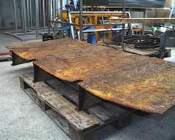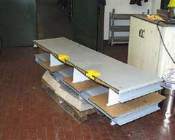UK: Composite plate system eases marine repairs
April 2001 Vol. 222 No. 4 Feature Article UNITED KINGDOM: Composite plate system eases marine repairs Intelligent Engineering (IE) has designed and patented
UNITED KINGDOM:Composite plate system eases marine repairsIntelligent Engineering (IE) has designed and patented the new Sandwich Plate System (SPS). SPS replaces conventional stiffened steel plates in maritime and civil structures with a steel-elastomer-steel, composite-structural laminate that provides performance, cost and safety benefits. The technology is applicable to production platforms, mobile drilling rigs, mobile offshore production units and other vessels / structures. IE has a joint venture with BASF / Elastogran, through which this system is now commercially available. SPS technology eliminates stiffeners. The result is less complexity; lower weight; less susceptibility to corrosion and fatigue; lower cost to build, operate and maintain; and increased service life. In addition, the laminate’s physical properties yield such additional benefits as superior impact resistance; greater vibration damping; and improved thermal and acoustic insulation. The system can be used in virtually all stiffened steel plate applications.
Test case proves the technology. Work done in January 2001 on a European ferry, P&O’s European Seafarer, provides an example of the overlay application. The vessel owner did not want the ship taken out of service for the long time required for conventional main deck repair. Thus, P&O selected the SPS method, as it could be done in half the normal time, and at lower cost. IE and Elastogran / BASF designed an overlay and managed the repair’s Class (DNV) approval process. They also supplied the elastomer, equipment and personnel for the injection. Cammell Laird prepared all the steel work. Once the design was approved, there were three steps to the process. The first step was to shot blast existing steel plate. After many years, the deck surface had a "washboard" appearance, although underneath it was in good condition. SPS overlay reinstates structural integrity without disturbing anything beneath the surface (e.g. pipework, cables, insulation). Step two welded plate spacers and flat backing bars to the existing deck above and along supporting girders. New, large steel plates, which became the new deck surface, were welded to the bars to form cavities into which polyurethane elastomer was injected. New pots were installed between the deck logitudinals, prior to elastomer injection, flush with the new deck. Elastomer was injected in step three. A typical cavity
had a surface area of 20 sq m (215 sq ft). It was possible to inject eight panels in an 8-hr shift. The
overlay conducted on the European Seafarer increased flexural stiffness and strength over the original
deck structure for the addition of negligible load. Thus, the procedure resulted in a better final product,
with considerable time and expense saved. |
||||||




